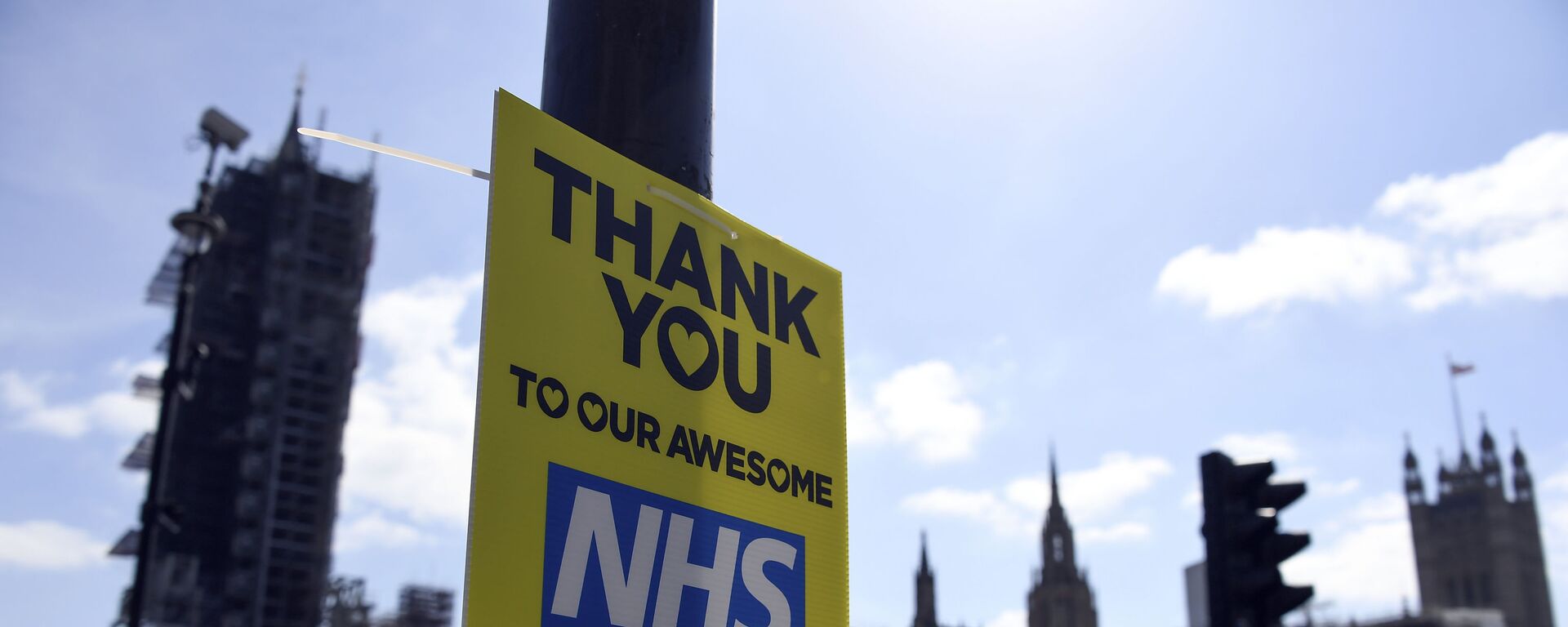https://sputnikglobe.com/20211124/how-confusing-covid-messaging--chronic-underinvestment-in-uk-healthcare-caused-soaring-wait-lists-1090978485.html
How Confusing COVID Messaging & Chronic Underinvestment in UK Healthcare Caused Soaring Wait Lists
How Confusing COVID Messaging & Chronic Underinvestment in UK Healthcare Caused Soaring Wait Lists
Sputnik International
The number of people waiting for non-urgent treatment on the NHS waiting list may exceed 6 million by the end of 2021, warns UK Health Secretary Sajid Javid... 24.11.2021, Sputnik International
2021-11-24T08:35+0000
2021-11-24T08:35+0000
2023-05-28T15:17+0000
boris johnson
national health service (nhs)
world
opinion
healthcare
sajid javid
covid-19
united kingdom (uk)
https://cdn1.img.sputnikglobe.com/img/07e4/08/08/1080101111_0:160:3073:1888_1920x0_80_0_0_d45a5fa3b34e579e5179f12db216f259.jpg
The NHS waiting list is continuing to soar because some seven to eight million people with non-COVID conditions stayed away from health services during the peak of the pandemic, according to Sajid Javid. "They did what was asked of them," the health secretary said.Official figures from NHS England indicate that a total of 5.83 million people in England were waiting to start treatment at the end of September 2021 - the highest number since records started in August 2007. According to Javid, this figure now amounts to 5.9 million.The trend suggests that the list is rising by around 100,000 people per month, according to iNews. However, Chris Hopson, the chief executive of NHS Providers, has warned that the NHS is facing an "unprecedented degree of pressure" – due to a combination of underfunding, COVID and social care failures – even before the traditional winter peak. Meanwhile, The Telegraph revealed last week that 9,300 more people than usual had died in the past four months from non-coronavirus causes.Confusing Messaging Led to Life LossesDuring the pandemic, the NHS coped with the pressure by suspending its equal access to healthcare approach, Germain points out. Some of the care was moved online and routine screening was cancelled in many areas to make room for COVID-19 infected patients in need of urgent care."This marked a turn towards a more utilitarian approach (focusing on consequences of treatments and health outcomes) when deciding how to allocate resources," she stresses. "Undoubtedly this also led to a backlog of treatments and has had devastating effects from patients suffering from various life-threatening conditions. It is also estimated that these measures have resulted in many additional deaths."However, workforce and staffing was an issue even before the pandemic, according to the academic. The outbreak has exposed the existing problems and specifically hit ethnic minority, underserved and underprivileged communities that have been experiencing barriers in accessing healthcare services, she underscores."The backlog of treatments could have been there before COVID as well," echoes Dr. Bharat Pankhania, infectious disease specialist and senior clinical lecturer at University of Exeter Medical School.Ten years of austerity has reduced capacity in the health service and has increased poverty, which could translate into a further spike in cases and bigger backlogs, according to the academic. In addition, Pankhania expects waiting list deaths to increase since some of the conditions went on to become chronic and more serious during the pandemic.'UK Needs to Invest & Increase Capacity in NHS'The options to solve the healthcare problem are very limited as one cannot generate capacity in the short term, according to Bharat Pankhania.For her part, Sabrina Germain proposes taking simple measures to reduce the rate of COVID-19 infections to relieve some of the pressure on the system and help to resume care faster. "For this, an indoor mask mandate would be very minimal but very efficient to tackle infections," she remarks.However, both healthcare experts believe that short-term fixes won't save the day emphasising the necessity to invest and increase capacity in the National Health Service.Germain suggests that resources must be mobilised in this area and treatments are to be delivered around the clock – outside regular working hours – to tackle the waiting lists. She further argues that investments in technology may also be necessary to ensure quicker diagnosing. The main focus, however, should be on equal access to healthcare services for all social groups, she says.
https://sputnikglobe.com/20211122/uk-nhs-waiting-list-may-reach-6-million-by-end-of-year-sajid-javid-warns-1090913149.html
https://sputnikglobe.com/20210723/nhs-stretching-thin-trying-to-cope-with-rising-infections-and-uk-govt-isnt-making-things-easier-1083440189.html
https://sputnikglobe.com/20210210/uk-pm-johnsons-health-care-reform-plan-comes-as-covid-exposes-shortcomings-of-nhs-academic-says-1082028508.html
united kingdom (uk)
Sputnik International
feedback@sputniknews.com
+74956456601
MIA „Rosiya Segodnya“
2021
News
en_EN
Sputnik International
feedback@sputniknews.com
+74956456601
MIA „Rosiya Segodnya“
Sputnik International
feedback@sputniknews.com
+74956456601
MIA „Rosiya Segodnya“
boris johnson, national health service (nhs), opinion, healthcare, sajid javid, covid-19, united kingdom (uk)
boris johnson, national health service (nhs), opinion, healthcare, sajid javid, covid-19, united kingdom (uk)
How Confusing COVID Messaging & Chronic Underinvestment in UK Healthcare Caused Soaring Wait Lists
08:35 GMT 24.11.2021 (Updated: 15:17 GMT 28.05.2023) The number of people waiting for non-urgent treatment on the NHS waiting list may exceed 6 million by the end of 2021, warns UK Health Secretary Sajid Javid. Academics Dr. Sabrina Germain and Dr. Bharat Pankhania believe that the only way to solve the problem is to considerably step up investments in the country's healthcare system.
The NHS waiting list is continuing to soar because some seven to eight million people with non-COVID conditions stayed away from health services during the peak of the pandemic, according to Sajid Javid. "They did what was asked of them," the health secretary said.
Official figures from NHS England indicate that a total of 5.83 million people in England were waiting to start treatment at the end of September 2021 - the highest number since records started in August 2007. According to Javid, this figure now amounts to 5.9 million.
The trend suggests that the list is rising by around 100,000 people per month,
according to iNews. However, Chris Hopson, the chief executive of NHS Providers, has warned that the NHS is facing an "unprecedented degree of pressure" – due to a combination of underfunding, COVID and social care failures – even before the traditional winter peak. Meanwhile, The Telegraph
revealed last week that 9,300 more people than usual had died in the past four months from non-coronavirus causes.

22 November 2021, 05:26 GMT
Confusing Messaging Led to Life Losses
"The communication around the prioritisation of COVID-19 patients was unclear and confusing," says Dr. Sabrina Germain, a senior lecturer at the City Law School and member of City University's Centre for Healthcare Innovation Research. "Particularly the slogan ‘Stay home, Protect the NHS, Save lives!’ which was indeed interpreted by many as stay away from the healthcare system to help deal with the pandemic."
During the pandemic, the NHS coped with the pressure by suspending its equal access to healthcare approach, Germain points out. Some of the care was moved online and routine screening was cancelled in many areas to make room for COVID-19 infected patients in need of urgent care.
"This marked a turn towards a more utilitarian approach (focusing on consequences of treatments and health outcomes) when deciding how to allocate resources," she stresses. "Undoubtedly this also led to a backlog of treatments and has had devastating effects from patients suffering from various life-threatening conditions. It is also estimated that these measures have resulted in many additional deaths."
However,
workforce and staffing was an issue even before the pandemic, according to the academic. The outbreak has exposed the existing problems and specifically hit ethnic minority, underserved and underprivileged communities that have been experiencing barriers in accessing healthcare services, she underscores.
"The backlog of treatments could have been there before COVID as well," echoes Dr. Bharat Pankhania, infectious disease specialist and senior clinical lecturer at University of Exeter Medical School.
Ten years of austerity has
reduced capacity in the health service and has increased poverty, which could translate into a further spike in cases and bigger backlogs, according to the academic. In addition, Pankhania expects waiting list deaths to increase since some of the conditions went on to become chronic and more serious during the pandemic.
"As a result of COVID and mixed messaging, we will have losses in two ways: first, directly due to infection and, second, indirectly, due to unmanaged high blood pressure, diabetes, heart disease, strokes, and cancers," the infectious disease specialist explains.

10 February 2021, 05:15 GMT
'UK Needs to Invest & Increase Capacity in NHS'
The options to solve the healthcare problem are very limited as one cannot generate capacity in the short term, according to Bharat Pankhania.
For her part, Sabrina Germain proposes taking simple measures to reduce the rate of COVID-19 infections to relieve some of the pressure on the system and help to resume care faster. "For this, an indoor mask mandate would be very minimal but very efficient to tackle infections," she remarks.
However, both healthcare experts believe that short-term fixes won't save the day emphasising the necessity to invest and increase capacity in the National Health Service.
Germain suggests that resources must be mobilised in this area and treatments are to be delivered around the clock – outside regular working hours – to tackle the waiting lists. She further argues that investments in technology may also be necessary to ensure quicker diagnosing. The main focus, however, should be on equal access to healthcare services for all social groups, she says.
Nevertheless, Germain expects that the pandemic will have long term effects on the system: "Policy experts talk about a once in a generation type of disruption and a backlog that could last for a minimum of six years," the academic concludes.







